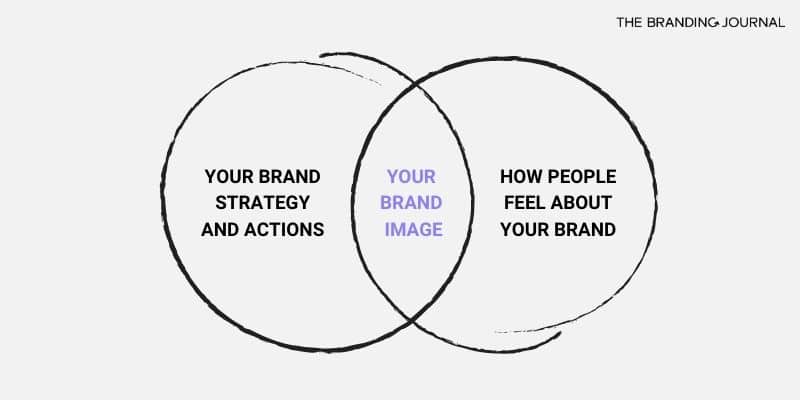Brand image plays a central role in defining which brands can better survive and succeed in their relative markets. This article defines brand image and outlines its importance, before looking at building, improving, and measuring brand image to better position yourself in the market.
Proven Systems for Business Owners, Marketers, and Agencies
→ Our mini-course helps you audit and refine an existing brand in 15 days, just 15 minutes a day.
→ The Ultimate Brand Building System is your step-by-step blueprint to building and scaling powerful brands from scratch.
Table of Contents
What Is a Brand Image?
Two leading branding academics, David Aaker and Kevin Keller have proposed two definitions of brand image:
“A set of associations relating to things like product attributes, benefits or price, that are organized in meaningful ways.” (Aaker, 1993)
“Perceptions about a brand reflected as associations in the minds of consumers” (Keller, 1993)
Keller believes that associations are built up as we:
- Directly experience brands and receive information about them
- Indirectly make inferences based on our pre-existing brand knowledge, for example, country of origin.
Suppose the attributes and benefits of the brand positively satisfy customers. In that case, there will be an overall favorable attitude towards the brand, and the brand can be said to have a positive brand image.
Put simply, brand image is all about how people feel about a brand and how they perceive it. It’s important to note that even those who do not need or use your products or services can form associations and create an image of you in the same way, so brand image is essential across the board.

Distinguishing Brand Image from Other Branding Concepts
Brand Image vs. Brand Identity
Confusing brand image and brand identity is something Aaker calls the “brand image trap” (Aaker, 1996).
Brand identity concerns what the company is trying to communicate about itself and the associations it wants customers to form regardless of whether this turns out to be the end result or not.
It is this end perception that consumers actually hold which is brand image. A company can control its brand identity and always endeavor to align this with the brand image that actually exists externally in consumers’ minds.
| Brand Identity | Brand Image |
| Developed internally | Developed externally |
| Who do you want to be? (The company’s desired image) | How do consumers feel about you? (The consumer’s perceived image) |
| Active in nature | Passive in nature |
| Forward-looking: continually trying to create and establish your desired identity | Backward-looking: your identity based on consumers’ changing perceptions of you over time |
Brand Image vs. Brand Awareness
Brand awareness is also often confused with brand image.
Brand awareness concerns how consumers can think of a brand when they begin a product or service search. It’s all about brand salience and how prominent a brand is in a consumer’s mind, and therefore relates more to memory and recall.
Brand image, however, concerns the brand associations and perceptions built-up over time which paints a picture of the brand overall.
Why is Brand Image So Important?

1. Competitive Advantage
Brand image can positively impact brand equity and is therefore vital to capturing a larger proportion of the market share. This allows companies to charge premium prices, which customers will actually be willing to pay or implement brand or product extension strategies more successfully since consumers view you positively and therefore trust you to deliver.
2. Positive Reputation
A positive brand image implies that existing and potential customers view your brand as being one that satisfies or could satisfy their needs successfully (through physical product attributes and benefits, or more intangible benefits such as a desirable price point).
3. Overall Reflection of Management
As perceived by consumers, your brand image can be seen as a reflection of how well you manage your business and meet the needs of the market overall. This will impact how well you can compete with other incumbent firms.
How to Build Brand Image?
1. Work on Your Brand Identity
A company cannot control its brand image but can manage its brand identity, amongst other aspects of a brand strategy. Therefore it’s essential to truly understand what you want your brand to stand for, and communicate this effectively to the market and beyond. This ensures the company can build up positive associations, which are then converted into the perceptions comprising brand image.
Sending out well-defined messages about the values and missions underpinning your brand can, in turn, lead to positive external perceptions (brand image) which align closely with your internally desired identity (brand identity).
Similarly, it’s vital to ensure that your values and missions are relevant and valuable to your target audience. Being customer-centric enables you to indirectly impact the associations consumers form towards you, allowing you to influence the creation of brand images indirectly.
2. Create Positive Customer Experiences
Brand image is primarily formed through direct experiences customers have with your brand. Making a good impression at all customer touch-points therefore becomes crucial.
This might be a seamless online experience or a physical in-store experience comprised of excellent customer service. This means well-trained and enthusiastic employees, as well as ensuring that your store is clean and easy to navigate or that your packaging is attractive and speaks to your desired identity.
3. Position Your Brand Well
Positioning concerns how you intend to deliver value to consumers in a unique and personal way to your target customer. Amazon, for example, has a mission to “continually raise the bar of the customer experience by using the internet and technology to help consumers find, discover and buy anything…” (https://www.aboutamazon.co.uk/uk-investment/our-mission).
This immediately speaks to how Amazon wishes to be perceived by consumers, and through this clear statement, if delivered to consumers successfully, Amazon can indirectly build its brand image.
4. Invest in Effective Communications
There is no use in formulating your desired identity and attempting to shape a consumer’s real image of you without adequate means of communication. Brand image can be influenced by creatively advertising what you stand for, thereby creating strong, unique, and relevant associations in consumers’ minds.
How to Improve Brand Image?

Since companies can only control brand image indirectly and to a limited extent, it’s important to improve your existing brand image as best as possible. This can be done very practically in several ways, for example:
- Monitoring word of mouth, which can contribute to the formation of perceptions that comprise brand image
- Ensuring consistent delivery of the value you promise to consumers in your positioning statement
- Continually communicating your unique values and attributes through marketing strategies
- Providing high-quality products or services, focusing on the customer experience
How to Measure Brand Image
Measuring brand image using a single metric can be tricky since it concerns subjective perceptions. However, it remains important in allowing managers to identify positive and negative associations of their brand, which they can then address and realign with their core values and missions.
Some ways you can measure brand image include:
1. Measuring Brand Perception via Focus Groups, Surveys, and Social Media Listening
This involves understanding how consumers perceive your brand. The more positive their perceptions, the more favorable your brand image:
- Brand perception surveys enable companies to evaluate how and how well consumers resonate with their brand and how far they understand the values and missions you are trying to convey.
- Focus groups can achieve similar results through more informal discussions where organizations can gauge the general beliefs and attitudes towards a brand, and from there, gain an understanding of the overall strength and nature of the brand image.
- Social Media Listening can be achieved via monitoring conversations and mentions involving the brand on social media
2. Brand Concept Maps
These are visual representations of brand associations as formed by consumers.
The first step is to identify a set of associations through conducting market research (perhaps using focus groups or surveys as mentioned above).
Secondly, an organization can map out these associations as relevant to their brand before finally combining them to form an aggregate map depicting an overall sense of the company’s brand image (John et al. 2006).
3. Semantic Differential Scaling
This method uses polar opposite adjectives or adverbs as endpoints on a scale, which customers can use to rate a brand. Each response can be quantified by a numerical score which can then be used to find an average. This gives a company an overall sense of how positively their brand is perceived, and hence how positive or negative their brand image is (Plumeyer et al., 2017).
Brand Image Examples
Victoria’s Secret

Victoria’s Secret is often perceived as being only for very petite women, with products largely overpriced and therefore inaccessible, contributing to a poor brand image. On the other hand, the brand also has positive perceptions of being exclusive, high quality, and well-designed.
Coca-Cola

Coca-Cola is often perceived as fresh, joyful and positive, and is associated with moments with close friends, youth, and refreshment. Some consumers, however, might perceive Coca-Cola as unhealthy.
Nike

Nike is perceived predominantly as innovative, sleek and athletic, and is associated with victory, determination, and motivation.
Nike enhances these images through their advertising campaigns and celebrity endorsements, and interestingly the brand name itself is shared with the Greek goddess of victory.
Key Takeaways
- Brand image relates to how consumers view your brand, your offering, and what you stand for.
- Brand image is essential in developing strong brand equityBrand equity represents the value of a brand. It is the difference between the value of a branded product and the value of that product without that brand name attached to it. and therefore competing successfully in the market.
- Knowing and communicating what your brand stands for and creating positive customer experiences are significant ways you can indirectly build your brand image.









So much goes into branding and as a writer, I believe understanding the definition of the terms one is using is extremely important for clarity and professionalism. I’m book marking this article to help me clarify where my services fit within branding.